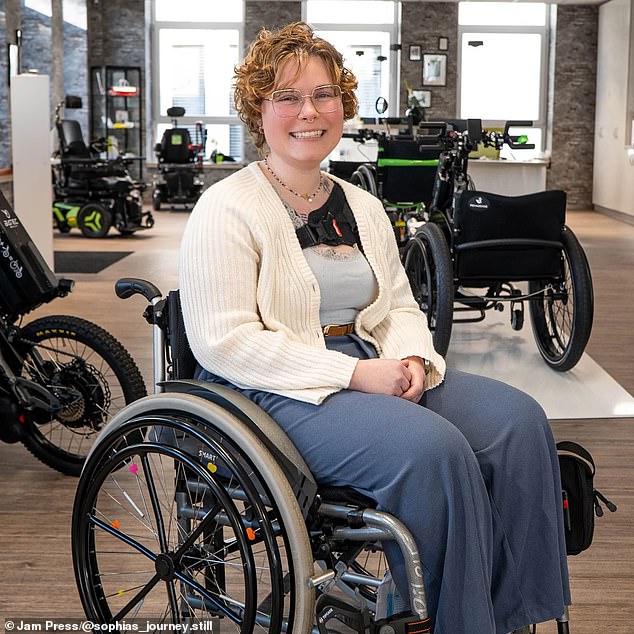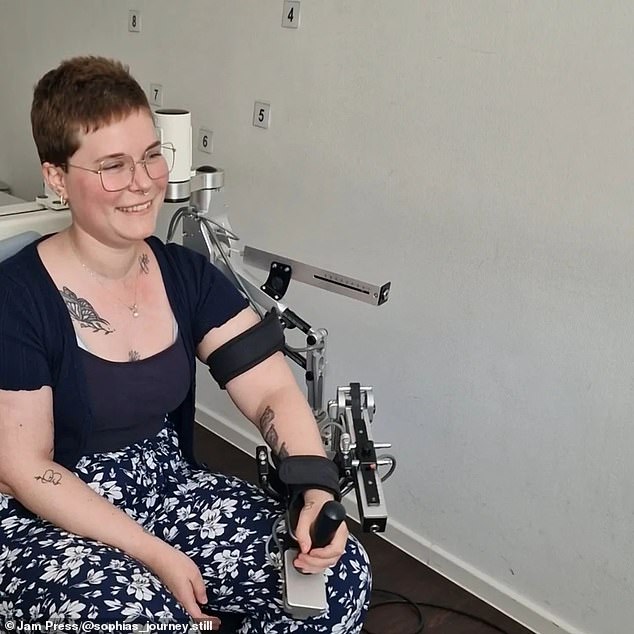My ‘stomach bug’ turned out to be a painful condition that left me in a wheelchair within four years
A 26-year-old woman has told how she ended up in a wheelchair and how her life was ‘ruined’ after contracting a stomach virus.
In the summer of 2018, Sophia Cucchiara suffered from frequent attacks of nausea, accompanied by high fevers, and she lost significant weight.
The former nursing student didn’t think about it and assumed she had a stomach virus.
Mrs Cucchaiara then developed swollen lymph nodes in her neck, joint pain and a rash, so she visited several doctors to get a diagnosis.
It was not until three years later, in September 2021, that an astute specialist performed the necessary tests to detect Still’s disease: a rare inflammatory form of arthritis.
Sophia Cucchiara thought she had all the classic symptoms of a stomach virus, but in reality this was the beginning of a four-year battle for the correct diagnosis.

Ms Cucchaiara said not knowing what was wrong with her body was the hardest part of her journey.
Speaking of the long ordeal, Mrs Cucchaiara from Cologne, Germanysaid, ‘I was anxious, worried and scared.
‘The hardest part of this time was not knowing what was wrong with my body.
‘Not only was it frustrating, I also started to doubt myself at times.
‘I convinced myself that I wasn’t sick at all and that I was just exaggerating, and that everyone has these symptoms. I’m just sensitive.
‘I couldn’t trust myself and my perception anymore, because no one could figure out why I felt so bad.
At one point in her diagnosis, specialists suspected she might have lymphoma, a deadly cancer of the immune system.
She said, “The oncologist was very sure, even before she took a biopsy.
‘She had even already informed me about the chemotherapy and the egg retrieval.

Ms Cucchaiara was eventually diagnosed with Still’s disease, a form of arthritis that affects 1 in 100,000 people
‘So I had already prepared myself and was very shocked that it wasn’t cancer.’
In early 2021, the pain became so bad that she was forced to give up her work and studies.
She was referred to a rheumatologist, a specialist in musculoskeletal disorders, who ultimately diagnosed her with Still’s disease.
‘I was happy. I thought we now knew what it was and we could try to fix it.
“I was relieved, especially because I finally knew that I wasn’t just imagining my illness.”
The disease is an autoimmune disorder that is only diagnosed in adults and is thought to affect only 800 people in the UK, or one in 100,000 adults.
It occurs when the immune system becomes dysregulated and inflammation occurs continuously, even when there is no infection or injury to heal.
Symptoms include sore throat, fever, joint pain, and a salmon-pink rash that comes and goes quickly.

Despite taking multiple medications, Ms. Cucchaiara still experiences a lot of pain and relies on a wheelchair to get around.

Symptoms of Still’s disease may resemble those of a virus, such as fever, rash, and joint pain.
There are several medications that can help manage Still’s symptoms, including nonsteroidal anti-inflammatory drugs (NSAIDs), disease-modifying anti-rheumatic drugs, steroids, and biologic therapies.
Mrs. Cucchaiara injects herself with medication every day.
She said: ‘I’ve become accustomed to injecting myself every day and I’ve come to terms with the fact that there is no cure.
‘Some days are really hard, for example when I have to cancel appointments, when the pain is extra bad or when I’m in hospital.’
Despite the medication, she still suffers from terrible pain in her joints and muscles, and cramps in her bladder. The pain has become so bad that she relies on a wheelchair to get around.

Ms Cucchaiara had to give up her career as a nurse because of her disability and now wants to raise awareness about her condition.
She said: ‘I can’t say exactly where the most pain is because it varies from person to person. Often it’s the hips, knees and wrists, but sometimes it’s something completely different.’
‘I still have several tablets, I take 12 every day, and painkiller patches.
But I’m proud that I never gave up.
‘Thanks to my wheelchair, I can go on holiday again, visit festivals and concerts and travel with friends. None of this was possible before.’
Sophia, who cannot work as a nurse due to her condition, has now completed her training and will teach other junior nurses in the future.
She added: ‘I kept fighting and never gave up, and I won’t do that in the future either.’
‘It may be hard, there will be times when you don’t want to go on, but always remember the good times because they are always worth fighting for.’
